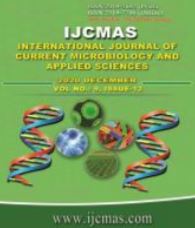


 National Academy of Agricultural Sciences (NAAS)
National Academy of Agricultural Sciences (NAAS)

|
PRINT ISSN : 2319-7692
Online ISSN : 2319-7706 Issues : 12 per year Publisher : Excellent Publishers Email : editorijcmas@gmail.com / submit@ijcmas.com Editor-in-chief: Dr.M.Prakash Index Copernicus ICV 2018: 95.39 NAAS RATING 2020: 5.38 |
Soil Test Crop Response based fertilizer prescription equations for desired seed yield target of glory lily were developed under Integrated Plant Nutrition System (STCR-IPNS) on Typic Rhodustalf (Palaviduthi soil series) of Tamil Nadu. On farm testing of STCR-IPNS equations are essential to demonstrate the effectiveness of technology to the clients. The present study was undertaken to evaluate the targeted yield model through field experiments at six locations in Dindigul district, Southern zone of Tamil Nadu. The treatments include control, blanket recommendation (RDF alone), soil test crop response (STCR) based fertilizer dose for the seed yield targets of 5.5, 6.5 and 7.5 q ha-1, STCR-IPNS based fertilizer dose for the seed yield targets of 5.5, 6.5 and 7.5 q ha-1 and farmer’s practice. Results elucidated that in all the six locations, the per cent achievement of the targeted yield was within  10 per cent variation proving the validity of the equations for prescribing integrated fertilizer doses for glory lily. The highest mean seed yield was recorded in STCR-IPNS – 7.5 q ha-1 (725 kg ha-1) recording an increase of 43.19 per cent over blanket recommendation. The highest response ratio and B:C ratio of 0.78 and 1.72 respectively were recorded in the yield target of 7.5 q ha-1 under STCR-IPNS. The post-harvest soil available NPK indicated the built up and maintenance of soil fertility due to soil test based fertilizer recommendation under IPNS. The fertilizer prescription equations developed for glory lily under IPNS can be recommended for red non calcareous soils of Tamil Nadu for achieving the yield target of 7.5 q ha-1 with sustained soil fertility and it can be extrapolated to other agro-climatic zones of Tamil Nadu on similar and allied soil types.
 |
 |
 |
 |
 |